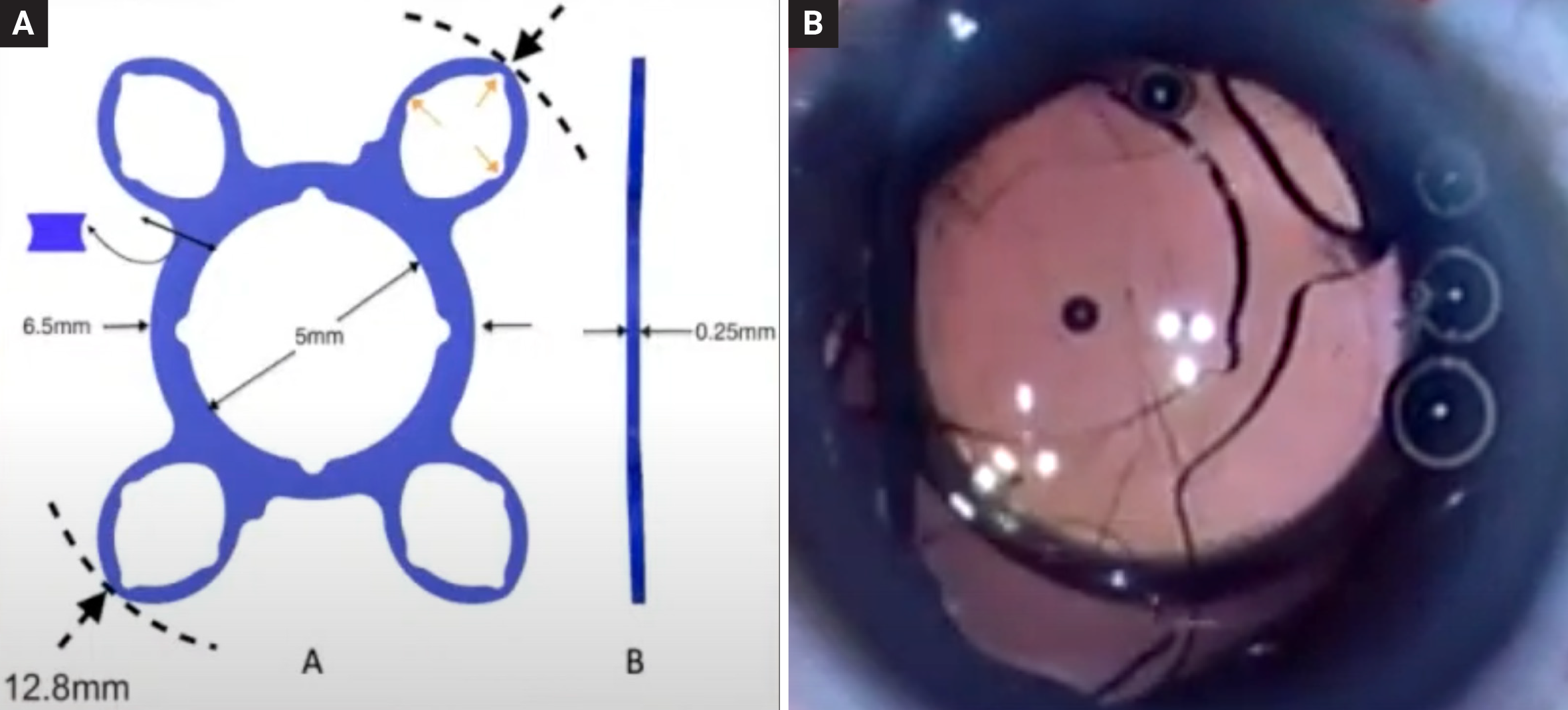 |
| The ND Ring, which is not yet available in the US, may help clinicians avoid common issues encountered with other intraoperative solutions. Figure A shows a diagram of the design and Figure B presents an intraoperative view of it during implantation. Photo: Prakhyat Roop, MD. Click image to enlarge. |
Editor’s Note: As part of our “Year in Review” retrospective, we’ve selected the top 30 news stories of the year and are re-sharing them as we close out 2023. Follow along as we count down to number 1!
This story was originally published October 2, 2023.
No. 11 biggest news story of 2023:
Reported to occur in about 15% to 20% of pseudophakic patients in the early postoperative phase, negative dysphotopsia (ND)—typically a dark crescent in the temporal periphery—persists after one year in about 2% to 3%. Surgeons have a number of options to counteract it, such as displacing, truncating or replacing the IOL. Another (and presumably simpler) approach under investigation is to implant a sulcus-fixated device called the ND Ring that compensates for the optical disturbance while keeping the original IOL intact. The device was developed by Prakhyat Roop, MD, of New Delhi.
In a recent study by Dr. Roop and colleagues, ND Ring implantation was evaluated for safety and efficacy for exactly that: treatment and prevention of ND. Dr. Roop holds a patent on the ND Ring and has a proprietary interest in it.
The prospective study included 22 total patients with ND. The ring was implanted in 15 eyes as a form of treatment for ND; this was considered the therapeutic group. The other group (seven eyes) used the device prophylactically, implanting it during cataract surgery of the fellow eye to prevent occurrence of ND. Minimum follow-up of one year for all eyes took place.
The study found positive results. The therapeutic group had 93.3% (n=14) of eyes report complete ND resolution on the first postoperative day; only one reported the persistence of a smaller and lighter temporal shadow. Of the seven treated prophylactically, none reported ND. Even greater, no significant adverse intraoperative events took place. Only in 9% of eyes (two out of 22) did vitreous up-thrust occur. Even better, no permanent drop in visual acuity happened in the therapeutic group.
The authors explain that this device targets only ND, differentiating it from most other management options currently in practice. As well, its function is unique, addressing peripheral retinal shadow between the light rays refracted by the nasal intraocular lens optic and the rays that miss the optic. Through this, it solves the issue of reflection of acutely incident light rays from anterior capsular remnant, which is also an ND cause.
While prior literature has reported partial success in various treatments, the authors note that surgical maneuvers like intraocular lens exchange can lead to compromised visual outcomes, thus necessitating a simpler solution that does not threaten visual outcomes. Dr. Roop’s paper for Journal of Cataract and Refractive Surgery explains that the ND Ring is compatible with any model or orientation of intraocular lens in the bag, so the surgeon can offer ND treatment or prophylaxis without needing to modify lens choice. As well, the device is thin and can be placed in the sulcus without posterior intraocular lens-bag complex crowding or bowing. Implantation takes about three minutes of surgical time, whereas other options require much greater anterior chamber manipulation and expensive tools.
Given the favorable safety and efficacy of the implantation, the authors concluded that “the results of this study provide positive outcomes in favor of this device being a feasible treatment of ND with the potential to evolve as a first-line option. We hope that this device is explored in greater detail by other clinicians for its efficacy and reliability.”
Roop P, Nayak S, Kittur A, Roop R, Sharma N. Evaluation of a novel device to treat negative dysphotopsia. J Cataract Refract Surg. September 27, 2023. [Epub ahead of print]. |

